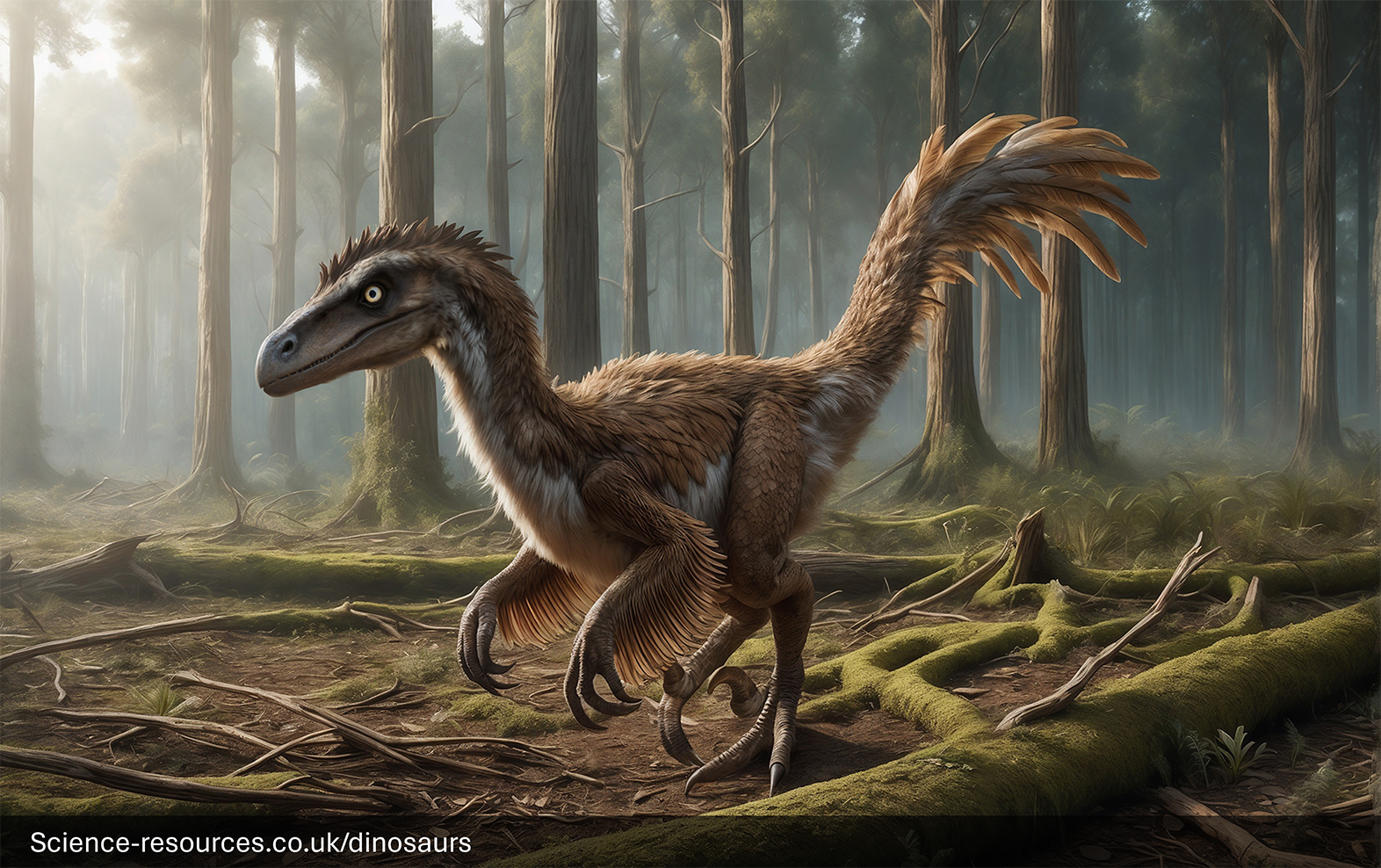Dinosaurs A:Z | D
You may also be intrested in: Free Dinosaur games
Dinosaurs: Deinonychus (Terrible Claw)
You may also be intrested in: Free Dinosaur games
Last updated: 8th Feb 2024 Deinonychus was a small, meat-eating dinosaur that lived during the Early Cretaceous period, around 145 to 100 million years ago. It’s famous for its large, sickle-shaped claws on each foot and is considered one of the most agile and intelligent predators of its time. • Length: Deinonychus grew to about 3 meters (10 feet) long. • Height: It stood about 1.5 meters (5 feet) tall at the hip. • Weight: Deinonychus weighed approximately 80 kg (175 pounds). Deinonychus had a distinct look with its three-fingered clawed hands and four-toed clawed feet. It had a stiff tail that helped it balance and make quick turns. Its most notable feature was the large, sickle-like claw on the second toe of each foot, which was used to attack prey. Additionally, Deinonychus likely had feathers, similar to its close relatives like Velociraptor. Deinonychus Generative AI Notification: Some elements of this image have been created or enhanced using AI technology. To find out how we create all our dinosaurs, click here. Deinonychus was a carnivore, meaning it ate meat. It had sharp teeth and claws designed to catch and eat other dinosaurs. It likely hunted in packs, allowing it to take down prey much larger than itself, such as Tenontosaurus. Fossils of Deinonychus have been found in what is now North America, particularly in states like Montana. They lived in a variety of environments, from forests to floodplains. • Deinonychus had a very large brain compared to its body size, suggesting it was very intelligent for a dinosaur. • It had a long, stiff tail that helped it maintain balance while running and attacking prey. • The name Deinonychus means "terrible claw" in Greek, referring to its fearsome foot claws. • Deinonychus was a close relative of Velociraptor, and its image was used as the model for the "raptors" in the Jurassic Park movies. Deinonychus was a member of a group of dinosaurs called Dromaeosaurids. This group included other small to medium-sized predators like Utahraptor, Microraptor, and Velociraptor. Dromaeosaurids were known for their agility, intelligence, and sickle-shaped claws. What is a Deinonychus?
How big was Deinonychus?
Appearance

What did Deinonychus eat?
Where did Deinonychus live?
Interesting facts
Which family of dinosaurs did Deinonychus belong to?
Pronounced: DIE-no-NIKE-us


Deinonychus Facts
Name Means: "Terrible Claw"
Length: 10 feet (3 m)
Height: 5 feet (1.5 m)
Weight: 175 pounds (80 kg)
Diet: Carnivore (Meat)
Time: Early to Mid Cretaceous - 120 million years ago
Habitat: Open
Woodland
Fossils Found: Western North America
Deinonychus, often seen as a fast hunter, may not have been as agile as once thought. Researchers believe it wasn't particularly quick compared to other dinosaurs, though not slow either. Its short lower leg bones might have helped with its toe-claw attacks by absorbing impact. Some scientists think the claws were used for climbing or pinning prey like Tenontosaurus and Zephyrosaurus.
There is no evidence that Deinonychus had feathers, but scientists believe it likely did.
• Hunting: The claws were used to catch and hold onto prey. Some scientists believe they were used in a slashing motion to injure prey during an attack.
• Climbing: The claws may have also helped Deinonychus climb trees and other surfaces.
• Defense: The claws could be used to defend against other predators.
Q1: What is a Deinonychus?
A1: Deinonychus was a medium-sized, carnivorous dinosaur that lived during the Early Cretaceous period, around 115 to 108 million years ago. It is known for its sharp claws and agility.
Q2: How big was the Deinonychus?
A2: Deinonychus could grow up to 3-4 meters (10-13 feet) long and weighed between 70 to 100 kilograms (150-220 pounds).
Q3: What did Deinonychus eat?
A3: Deinonychus was a carnivore, meaning it ate meat. It likely hunted small to medium-sized dinosaurs and other animals.
Q4: How did Deinonychus move?
A4: Deinonychus was a fast and agile runner, moving on two legs. It had a long tail that helped it balance while running and making quick turns.
Q5: Where have Deinonychus fossils been found?
A5: Fossils of Deinonychus have been discovered in North America, particularly in the United States, in states like Montana, Wyoming, and Oklahoma.
Q6: What makes Deinonychus unique among dinosaurs?
A6: Deinonychus is unique because of its large, sickle-shaped claw on each hind foot, which it used to catch and hold onto prey. It also had keen eyesight and a flexible neck.
Q7: How do scientists learn about Deinonychus?
A7: Scientists study fossils, including bones and sometimes footprints, to learn about Deinonychus. They also use modern technology like CT scans and computer models to understand how it moved and lived.
Q8: Did Deinonychus live alone or in groups?
A8: Evidence suggests that Deinonychus may have hunted in packs, similar to modern wolves, which would have made them more effective predators.
Q9: What new discoveries have been made about Deinonychus?
A9: Recent studies have provided new insights into the social behaviour and hunting strategies of Deinonychus, showing that it likely coordinated with others to hunt more effectively.
Q10: Why is Deinonychus important to study?
A10: Studying Deinonychus helps scientists understand more about the behaviour and evolution of predatory dinosaurs and their role in the ecosystems of the Early Cretaceous period.
How fast was Deinonychus?
Did Deinonychus have feathers?
What were the claws of a Deinonychus for?
Deinonychus FAQ
You may also be intrested in:
Tags: How big was Deinonychus, Deinonychus size, where does Deinonychus live, how tall are Deinonychus, what does Deinonychus mean, Deinonychus, Deinonychus facts